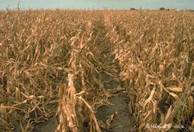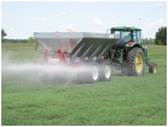Good afternoon,
This week I had the opportunity to participate in the Hardin County Soil and Water Conservation District’s Forestry Day and also the area Technician’s Tour. It is very interesting for me to learn about the different conservation projects and practices that are happening in the county with the help of the SWCD, Natural Resources Conservation Service, and the Ohio Department of Natural Resources. We saw a compost dairy barn, carrot harvesting and cover crop business, grass waterways, a concrete headwall, drainage diversion around a farm pond, and a tour of Precision Strip, Inc. I would like to thank everyone at the Soil and Water office for organizing this educational tour.
This week a committee met to begin planning the Tillage Club meetings which will be held at the Plaza Inn this winter. Suggested topics include grain marketing, controlling invasive and herbicide resistant weeds, plant diseases and fungicide economics, agricultural law and commercial driver’s license requirements for agriculture. Another possible topic might be managing field crop insect problems. Stay tuned for further updates as we get speakers and dates confirmed.
This weekend 25 active and retired sheep producers will be participating in the Hardin County Sheep Improvement Association’s Fall Sheep Management Tour. We will be traveling to Hancock, Holmes, and Marion Counties to visit three sheep farms and two sheep industry related locations. The goal of the tour is to learn new and different practices to help the local sheep producers with their operations. See the attached news release for more information.
Friday, November 1st the next Ag Council breakfast meeting at Henry’s Restaurant in Kenton. We will be meeting in the banquet room at 7:00 am to share information. Feel free to attend and share information about this fall’s harvest, elections, or other county agriculture news. See the articles below for additional information that may be of interest to you.
Mark
Harvest Delays Impact Corn Performance – Peter Thomison, Allen Geyer, Rich Minyo
Leaving corn to dry in the field exposes a crop to unfavorable weather conditions, as well as wildlife damage. A crop with weak plant integrity is more vulnerable to yield losses from stalk lodging and ear drop when weathering conditions occur. The widespread root lodging that occurred as a result of wind storms in July is contributing to this problem. Additional losses may occur when ear rots reduce grain quality and can lead to significant dockage when the grain is marketed. Some ear rots produce mycotoxins, which may cause major health problems if fed to livestock. To continue reading this article, go tohttp://corn.osu.edu/newsletters/2013/2013-36/harvest-delays-impact-corn-performance.
Prussic Acid Testing in Forages – Mark Sulc
Some forage species can develop prussic acid poisoning potential when harmed by frost and management practices should be followed to prevent poisoning of livestock (see Forage Toxicity Issues with Frosts article in CORN 2013-35). If doubt remains regarding the safety of the forage, it can be tested for prussic acid (cyanide) content. But keep in mind that prussic acid is a gas, so it is difficult to detect in samples sent to labs. Sample handling is extremely critical to ensure that the lab test will be representative of what is being fed to livestock and that the prussic acid did not volatilize during shipment. To find out more about how to test forages for prussic acid, go to http://corn.osu.edu/newsletters/2013/2013-36/prussic-acid-testing-in-forages-1.
Keys to Phosphorus Results on a Soil Test and Developing a P Recommendation – Greg LaBarge
One thing that has become very clear working with understanding soil test results over the past 18 months is when it comes to phosphorus we (universities, laboratories and practitioners) have made it very complicated. There are a variety of explanations that can be given for the different reporting but the bottom line is the collective “we” need and can do better. The discussion on environmental impacts will lead to more standardized soil test result reporting that will benefit agriculture for meeting both production and environmental goals. But until those discussions occur, there are a few key questions to ask when looking at phosphorus on your soil test results. Find out further information athttp://corn.osu.edu/newsletters/2013/2013-35/keys-to-phosphorus-results-on-a-soil-test-and-developing-a-p-recommendation.
OSU to Offer Year-end Tax Tips for Farmers at Nov. 4 Workshop – Tracy Turner, Larry Gearhardt
GREENVILLE, Ohio – Farmers and producers looking to plan ahead for tax filing this year can learn about federal tax law changes and updates, as well as potential money-saving tips they can use when filing 2013 tax returns, from tax experts at Ohio State University’s College of Food, Agricultural, and Environmental Sciences. A Nov. 4 workshop offered by Larry Gearhardt, director of the Ohio State University Income Tax School Program of Ohio State University Extension, will focus on interpreting tax regulations and recent changes in tax laws and is designed to help farmers learn what questions to ask to make more informed decisions about their taxes. For more information about this farmer tax workshop, go tohttp://cfaes.osu.edu/news/articles/ohio-state-university-offer-year-end-tax-tips-for-farmers-nov-4-workshop.
Plant Diagnostic Sample Submssion App avaialbe from Diagnostic Clinic
New from Ohio State University’s C. Wayne Ellett Plant and Pest Diagnostic Clinic is an app for iPhone or iPad which will allow Clinic clientele to submit digital samples or images either as stand-alone samples or to supplement a physical sample being sent to the Clinic. OSU’s Clinic joined with 7 university-based plant diagnostic laboratories in the development of the app which is available for free from the i-Tunes Store and can be found here: https://itunes.apple.com/us/app/sample-submission/id669269520?mt=8 or by scanning the QR code. Anyone may download and use the app which will guide the users with questions customized for various situations. The Clinic will charge its basic exam fee for digital samples submitted through the app.
While pictures are worth a thousand words they still do not always tell the whole story. Many plant disease or insect samples will still require microscopic examination or other types of specialized tests to confirm the diagnosis. If a physical sample is required as a follow-up to a digital sample the basic exam fee will be not be charged for that physical sample.
Please refer to the section of the Clinic’s web site which addresses submitting images:: http://ppdc.osu.edu/submit-sample/images-and-pictures
Universities/labs partnering in the development of the Plant Diagnostic Sample Submission app are:
• Alabama Cooperative Extension System
• University of Connecticut Plant Diagnostic Laboratory
• University of Illinois Extension
• University of Kentucky Plant Disease Diagnostic Laboratory (County ANR/HORT Agents only)
• Michigan State University Diagnostic Services Laboratory
• University of New Hampshire Cooperative Extension Plant Diagnostic Lab (UNHCE Field & State Specialists only)
• Ohio State University C. Wayne Ellett Plant and Pest Diagnostic Clinic
• Purdue University Plant and Pest Diagnostic Laboratory
Mark A. Badertscher
Agriculture and Natural Resources Educator
OSU Extension Hardin County
1021 W. Lima Street, Suite 103, Kenton, OH 43326
419-674-2297 Office




